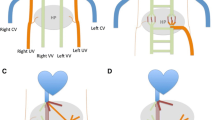Abstract
Purpose
Congenital portosystemic shunts (CPSS) with portal venous hypoplasia cause hyperammonemia. Acute shunt closure results in portal hypertension. A transcatheter method of staged shunt reduction to afford growth of portal vessels followed by shunt closure is reported.
Methods
Pressure measurements and angiography in the CPSS or superior mesenteric artery (SMA) during temporary occlusion of the shunt were performed. If vessels were diminutive and the pressure was above 18 mmHg, a staged approach was performed, which included implantation of a tailored reducing stent to reduce shunt diameter by ~50 %. Recatheterization was performed approximately 3 months later. If the portal pressure was below 18 mmHg and vessels had developed, the shunt was closed with a device.
Results
Six patients (5 boys, 1 girl) with a median age of 3.3 (range 0.5–13) years had CPSS portal venous hypoplasia and hyperammonemia. Five patients underwent staged closure. One patient tolerated acute closure. One patient required surgical shunt banding because a reducing stent could not be positioned. At median follow-up of 3.8 (range 2.2–8.4) years, a total of 21 procedures (20 transcatheter, 1 surgical) were performed. In all patients, the shunt was closed with a significant reduction in portal pressure (27.7 ± 11.3 to 10.8 ± 1.8 mmHg; p = 0.016), significant growth of the portal vessels (0.8 ± 0.5 to 4.0 ± 2.4 mm; p = 0.037), and normalization of ammonia levels (202.1 ± 53.6 to 65.7 ± 9.6 μmol/L; p = 0.002) with no complications.
Conclusion
Staged CPSS closure is effective in causing portal vessel growth and treating hyperammonemia.


Similar content being viewed by others
References
Witters P, Maleux G, George C et al (2008) Congenital veno-venous malformations of the liver: widely variable clinical presentations. J Gastroenterol Hepatol 23:e390–e394
Stringer MD (2008) The clinical anatomy of congenital portosystemic venous shunts. Clin Anat 21:147–157
Ferrero GB, Porta F, Biamino E et al (2010) Remittent hyperammonemia in congenital portosystemic shunt. Eur J Pediatr 169:369–372
Akahoshi T, Nishizaki T, Wakasugi K et al (2000) Portal-systemic encephalopathy due to a congenital extrahepatic portosystemic shunt: three cases and literature review. Hepatogastroenterology 47:1113–1116
Dhalluin-Venier V, Fabre M, Jacquemin E et al (2008) Liver cell adenomas and portosystemic shunt. Gastroenterol Clin Biol 32:164–166
Alvarez AE, Ribeiro AF, Hessel G et al (2002) Abernethy malformation: one of the etiologies of hepatopulmonary syndrome. Pediatr Pulmonol 34:391–394
Lisovsky M, Konstas AA, Misdraji J (2011) Congenital extrahepatic portosystemic shunts (Abernethy malformation): a histopathologic evaluation. Am J Surg Pathol 35:1381–1390
Morgan G, Superina R (1994) Congenital absence of the portal vein: two cases and a proposed classification system for portosystemic vascular anomalies. J Pediatr Surg 29:1239–1241
Howard ER, Davenport M (1997) Congenital extrahepatic portocaval shunts—the Abernethy malformation. J Pediatr Surg 32:494–497
Murray CP, Yoo SJ, Babyn PS (2003) Congenital extrahepatic portosystemic shunts. Pediatr Radiol 33:614–620
Tercier S, Delarue A, Rouault F et al (2006) Congenital portocaval fistula associated with hepatopulmonary syndrome: ligation vs liver transplantation. J Pediatr Surg 41:e1–e3
Lautz TB, Tantemsapya N, Rowell E, Superina RA (2011) Management and classification of type II congenital portosystemic shunts. J Pediatr Surg 46:308–314
Morikawa N, Honna T, Kuroda T et al (2008) Resolution of hepatopulmonary syndrome after ligation of a portosystemic shunt in a pediatric patient with an Abernethy malformation. J Pediatr Surg 43:e35–e38
Singhal A, Srivastava A, Goyal N et al (2009) Successful living donor liver transplant in a child with Abernethy malformation with biliary atresia, ventricular septal defect and intrapulmonary shunting. Pediatr Transpl 13:1041–1047
Emre S, Arnon R, Cohen E et al (2007) Resolution of hepatopulmonary syndrome after auxiliary partial orthotopic liver transplantation in Abernethy malformation. A case report. Liver Transpl 13:1662–1668
Kuo MD, Miller FJ, Lavine JE et al (2010) Exploiting phenotypic plasticity for the treatment of hepatopulmonary shunting in Abernethy malformation. J Vasc Interv Radiol 21:917–922
Franchi-Abella S, Branchereau S, Lambert V et al (2010) Complications of congenital portosystemic shunts in children: therapeutic options and outcomes. J Pediatr Gastroenterol Nutr 51:322–330
Wolschrijn CF, Mahapokai W, Rothuizen J et al (2000) Gauged attenuation of congenital portosystemic shunts: results in 160 dogs and 15 cats. Vet Q 22:94–98
Partington BP, Partington CR, Biller DS, Toshach K (1993) Transvenous coil embolization for treatment of patent ductus venosus in a dog. J Am Vet Med Assoc 202:281–284
Moore JW, Murphy JD (2000) Use of a bow tie stent occluder for transcatheter closure of a large anomalous vein. Catheter Cardiovasc Interv 49:437–440
Fanelli F, Salvatori FM, Rabuffi P et al (2009) Management of refractory hepatic encephalopathy after insertion of TIPS: long-term results of shunt reduction with hourglass-shaped balloon-expandable stent-graft. Am J Roentgenol 193:1696–1702
Kroma G, Lopera J, Cura M et al (2009) Transjugular intrahepatic portosystemic shunt flow reduction with adjustable polytetrafluoroethylene-covered balloon-expandable stents. J Vasc Interv Radiol 20:981–986
Stewart JK, Kuo WT, Hovsepian DM et al (2011) Portal venous remodeling after endovascular reduction of pediatric autogenous portosystemic shunts. J Vasc Interv Radiol 22:1199–1205
Passalacqua M, Lie KT, Yarmohammadi H (2012) Congenital extrahepatic portosystemic shunt (Abernethy malformation) treated endovascularly with vascular plug shunt closure. Pediatr Surg Int 28:79–83
Conflict of interest
Bruckheimer is a paid consultant for Atrium Medical Corp., Hudson, NH. The other authors declare that they have no conflict of interest.
Author information
Authors and Affiliations
Corresponding author
Rights and permissions
About this article
Cite this article
Bruckheimer, E., Dagan, T., Atar, E. et al. Staged Transcatheter Treatment of Portal Hypoplasia and Congenital Portosystemic Shunts in Children. Cardiovasc Intervent Radiol 36, 1580–1585 (2013). https://doi.org/10.1007/s00270-013-0581-7
Received:
Accepted:
Published:
Issue Date:
DOI: https://doi.org/10.1007/s00270-013-0581-7




